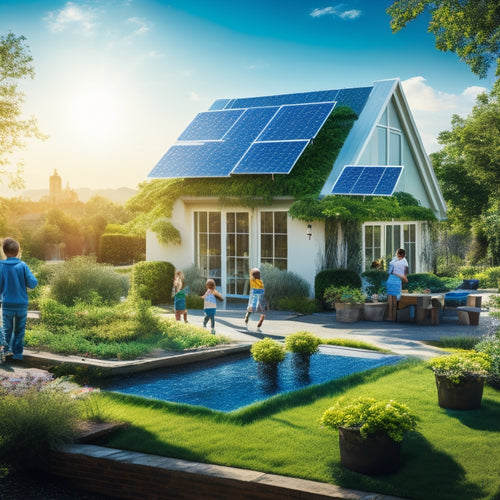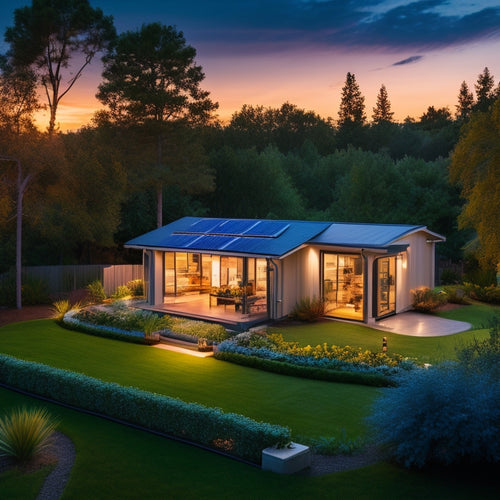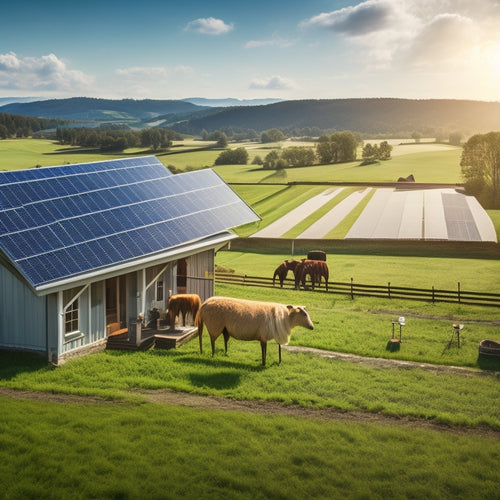Mistakes to Avoid in Residential PV Panel Selection
Share
When selecting residential PV panels, you'll want to avoid common mistakes that can lead to inefficient energy production, costly repairs, and even safety hazards. Failing to prioritize efficiency ratings can result in underperforming panels, while neglecting warranty and support can leave you with costly repairs and no recourse. Overlooking certifications can compromise performance and safety, and misunderstanding power output needs can lead to undersizing or oversizing. Additionally, disregarding durability and materials can compromise the entire solar energy system, and ignoring roof compatibility can lead to installation issues. By being aware of these pitfalls, you'll be well on your way to making an informed decision that meets your energy needs.
Key Takeaways
- Prioritize efficiency ratings above 20% for optimal power output and consider performance metrics like temperature coefficient and fill factor.
- Accurately determine power output needs through a thorough load analysis to avoid oversizing or undersizing the solar energy system.
- Verify comprehensive warranties with clear processes and minimal loopholes, and assess manufacturer reliability and customer support quality.
- Ensure certifications like UL 1703 and IEC 61215 compliance, and verify manufacturer commitment to quality management through ISO 9001 certification.
- Neglecting material quality and durability can compromise the entire solar energy system, so prioritize high-quality frames, encapsulants, and materials.
Ignoring Efficiency Ratings
Typically, PV panel shoppers focus on the upfront cost, overlooking a critical factor: efficiency ratings. This can be a costly mistake, as higher-efficiency panels can generate more power per unit area, ultimately saving you money in the long run.
When you're comparing different PV panels, you need to take into account the efficiency comparison to make an informed decision.
Efficiency ratings are measured by the amount of sunlight that's converted into electrical energy. Look for panels with high efficiency ratings, typically above 20%. This will guarantee you're getting the most power out of your installation.
Don't just take into account the wattage; instead, examine the performance metrics, such as the temperature coefficient and fill factor. These metrics will give you a more thorough understanding of the panel's performance.
Overlooking Warranty and Support
When selecting a PV panel, one essential aspect often falls by the wayside: the warranty and support offered by the manufacturer. You may be tempted to focus solely on the panel's performance and cost, but overlooking warranty terms and customer support can lead to costly mistakes down the line.
A thorough warranty should cover the panel's performance, materials, and workmanship for an extended period, typically 25 years or more. Look for manufacturers that offer a clear, straightforward warranty process with minimal loopholes.
You should also investigate the manufacturer's customer support, including their response time, availability, and quality of service. A reliable manufacturer will provide dedicated support channels, such as phone, email, or online portals, to address any issues or concerns you may have.
When evaluating warranty and support, consider the manufacturer's reputation, reliability, and financial stability. A manufacturer with a proven track record of honoring warranty claims and providing excellent customer support is more likely to stand behind their product over the long term.
Failing to Check Certifications
Beyond warranty and support, another significant factor to contemplate when selecting a PV panel is certifications. You may think that certifications are just a formality, but they're essential in guaranteeing the panel meets industry standards and regulations. Failing to check certifications can lead to subpar performance, safety issues, and even void your warranty.
| Certification Standard | Description |
|---|---|
| UL 1703 | Safety standard for PV modules and panels in the US |
| IEC 61215 | International standard for crystalline silicon PV modules |
| ISO 9001 | Quality management system standard for manufacturers |
When evaluating certifications, look for compliance with industry regulations such as UL 1703 and IEC 61215. These standards guarantee the panel meets safety and performance requirements. Additionally, check if the manufacturer has an ISO 9001 certification, which indicates a commitment to quality management. Don't assume that all PV panels meet these standards – it's your responsibility to verify certifications before making a purchase. By doing so, you'll avoid potential pitfalls and guarantee a reliable, high-performing PV system.
Misunderstanding Power Output Needs
When selecting a PV panel, you'll need to accurately determine your power output needs to guarantee a properly sized system.
Miscalculating your energy demands can lead to oversizing or undersizing, which can result in reduced efficiency and increased costs.
You must consider your specific energy requirements, peak sun hours, and other factors to get it right.
Assessing Energy Demands Incorrectly
In the midst of planning your solar panel installation, accurately gauging your energy demands is vital to avoid undersizing or oversizing your PV system. You must determine your energy consumption patterns to guarantee your system meets your power needs.
Conducting a thorough load analysis is important to understand your energy usage habits. This involves identifying the type and number of appliances, lighting, and devices you use, as well as their respective power ratings. You should also take into account your energy consumption patterns during peak and off-peak hours. Failing to do so may lead to inaccurate estimates of your energy demands, resulting in a poorly sized PV system.
To get it right, you'll need to gather data on your historical energy consumption. Review your past utility bills to determine your average daily energy usage.
You may also want to factor in considerations like energy efficiency upgrades, changes in occupancy, and future energy-intensive additions like electric vehicles or swimming pools. By doing so, you'll be able to accurately assess your energy demands and select a PV system that meets your specific power needs.
Oversizing or Undersizing Systems
Your solar panel system's power output needs are critical to meeting your energy demands. Oversizing or undersizing your system can lead to significant consequences, including reduced performance, increased costs, and decreased ROI.
When it comes to system sizing, it's vital to strike a performance balance that meets your energy requirements without over- or under-producing. Undersizing your system can result in insufficient power output, leading to unmet energy demands and reliance on the grid.
On the other hand, oversizing can lead to wasted energy, increased upfront costs, and potential issues with grid connection. To avoid these mistakes, you must accurately assess your energy demands and select a system that matches your needs.
Proper system sizing involves considering factors such as your energy usage patterns, roof size and orientation, and local building codes.
Ignoring Peak Sun Hours
Ignoring Peak Sun Hours (Misunderstanding Power Output Needs)
Solar irradiance, the amount of sunlight that hits your rooftop, plays an essential role in determining your solar panel system's power output. You need to take into account the peak sun hours (PSH) your location receives to accurately size your system and guarantee it meets your energy needs. PSH is the amount of sunlight intensity your area gets during the peak sun hours of the day.
You can't simply look at the total sunlight hours your location receives; you need to take into account the sunlight intensity during those hours. For instance, a location with high sunlight intensity during peak hours will generate more power than one with lower intensity, even if they receive the same total sunlight hours.
Additionally, your solar orientation and panel angle also impact your system's power output. Failing to account for PSH and these factors can lead to undersized or oversized systems, resulting in reduced energy production and increased costs.
Disregarding Durability and Materials
When selecting a PV panel, you're likely to focus on its power output and efficiency, but you shouldn't overlook the importance of durability and materials.
The quality of the frame, panel encapsulant, and other materials can greatly impact the panel's performance and lifespan.
If you don't consider these factors, you may end up with a panel that can't withstand environmental stresses or degrades quickly, compromising your entire solar energy system.
Frame Quality Matters
Many solar panels appear to be identical at first glance, but a closer inspection often reveals significant differences in frame quality. You might assume that all frames are created equal, but that's not the case. The type and quality of frame can greatly impact the overall performance and lifespan of your solar panel system.
When selecting a solar panel, you should consider the frame type, material, and coatings. Here's a breakdown of common frame types and their characteristics:
| Frame Type | Material | Coatings |
|---|---|---|
| Anodized Aluminum | Aluminum | Anodized layer for corrosion protection |
| Powder-Coated Aluminum | Aluminum | Powder coating for added durability |
| Stainless Steel | Stainless Steel | No additional coatings needed for corrosion resistance |
| Galvanized Steel | Steel | Zinc coating for corrosion protection |
| Carbon Steel | Steel | Paint or powder coating for corrosion protection |
You'll notice that anodized aluminum frames are a popular choice due to their corrosion resistance and durability. However, stainless steel frames offer superior corrosion resistance and are ideal for coastal or high-humidity environments. Powder-coated aluminum frames provide a cost-effective alternative, but may not offer the same level of durability as anodized or stainless steel frames.
Panel Encapsulant Importance
You've considered the frame quality of your solar panel, but now it's time to look beyond the frame's exterior. The encapsulant, a fundamental component, plays an important role in protecting the photovoltaic cells from environmental stressors.
It's important to understand the different encapsulant types, as they greatly impact the panel's performance and lifespan. Ethylene-vinyl acetate (EVA) and polyvinyl butyral (PVB) are the most common encapsulant types used in residential PV panels.
EVA, a popular choice, offers excellent optical clarity and is relatively inexpensive. PVB, on the other hand, provides superior mechanical strength and resistance to moisture. When selecting an encapsulant, consider the environmental conditions your panel will be exposed to. For example, if you live in a region with high humidity, a PVB-based encapsulant might be a better option.
The encapsulant lifespan is also important, as it directly affects the panel's overall performance. A high-quality encapsulant can last up to 30 years or more, making sure your panel maintains its energy output.
Be sure to research the encapsulant's warranty and manufacturer's reputation to confirm you're getting a reliable product.
Material Degradation Risks
Panel durability is a vital factor in PV panel selection, and overlooking material degradation risks can lead to premature failure. You must consider the material types and their degradation factors to guarantee your system operates efficiently over its expected lifespan.
Environmental impact, such as exposure to UV radiation, moisture, and temperature fluctuations, can greatly affect material longevity. Installation conditions, like shading or extreme weather, can also influence degradation rates. It's important to evaluate maintenance considerations and performance monitoring strategies to detect potential issues early on.
When selecting PV panels, you should prioritize material types with high moisture resistance and UV stability. Temperature effects, such as thermal cycling, can cause material fatigue, so it's imperative to choose panels with strong thermal management.
Not Considering Roof Compatibility
When selecting PV panels, it's essential to evaluate the roof's structural integrity and compatibility with the solar array.
You must verify that your roof can support the weight of the panels and withstand various environmental conditions. Failure to do so can lead to costly repairs, compromised energy production, and even safety hazards.
Some key considerations to keep in mind:
-
Roof age and condition: Will your roof need to be replaced soon, making it difficult to integrate with the solar array?
-
Roof size and layout: Are there obstructions, such as skylights or vents, that could impact panel placement and energy production?
-
Roof material and type: Will your roof's material (e.g., asphalt shingles, metal, or clay tiles) affect the installation techniques and aesthetic considerations?
-
Local building codes and regulations: Are there specific requirements or restrictions governing residential solar installations in your area?
-
Weight and load capacity: Can your roof support the weight of the panels, mounting system, and other equipment?
Frequently Asked Questions
Can I Install PV Panels Myself to Save Money?
You're considering a DIY installation to reap cost savings, but it's essential to weigh the risks: improper installation can void warranties, compromise system performance, and even pose safety hazards, potentially offsetting any initial savings.
How Often Should I Clean My PV Panels for Optimal Performance?
Did you know that dirty PV panels can reduce energy output by up to 25%? To maximize performance, you should clean your panels every 6-12 months, depending on location and climate, and follow maintenance tips like using soft brushes and deionized water.
Are PV Panels Affected by Extreme Weather Conditions?
You're right to wonder if extreme weather conditions affect your PV panels; the weather impact is significant, and panel durability is essential. Manufacturers guarantee panels can withstand harsh conditions, but you should still check the warranty for weather-related performance guarantees.
Can I Upgrade My PV Panel System in the Future?
You can future-proof your PV panel system by selecting modules with system compatibility in mind, ensuring a seamless upgrade path with emerging technologies, and opting for future-proofing features that enable hassle-free integration of new components.
Are There Any Government Incentives for PV Panel Installations?
You're eligible for government incentives, including tax credits and installation rebates, which can greatly reduce your PV panel system's upfront cost, making it more affordable and increasing your return on investment.
Conclusion
You've narrowed down your residential PV panel options, but don't finalize your decision just yet. You might be thinking, "What's the big deal if I overlook a few details? It's just a PV panel." However, those overlooked details can lead to subpar performance, reduced lifespan, and even safety hazards. By avoiding these mistakes, you'll guarantee a reliable, efficient, and cost-effective solar energy system that meets your needs for years to come.
Related Posts
-

Solar Energy Benefits for Sustainable Living
Solar energy provides numerous benefits for sustainable living that you can't overlook. By switching to solar, you'll...
-

Solar Power Backup Solutions During Outages
Solar power backup solutions guarantee you have reliable energy during outages, providing essential power when the gr...
-

Solar Power Systems for Rural Properties
Solar power systems offer a reliable and efficient energy solution for rural properties, allowing you to gain energy ...


